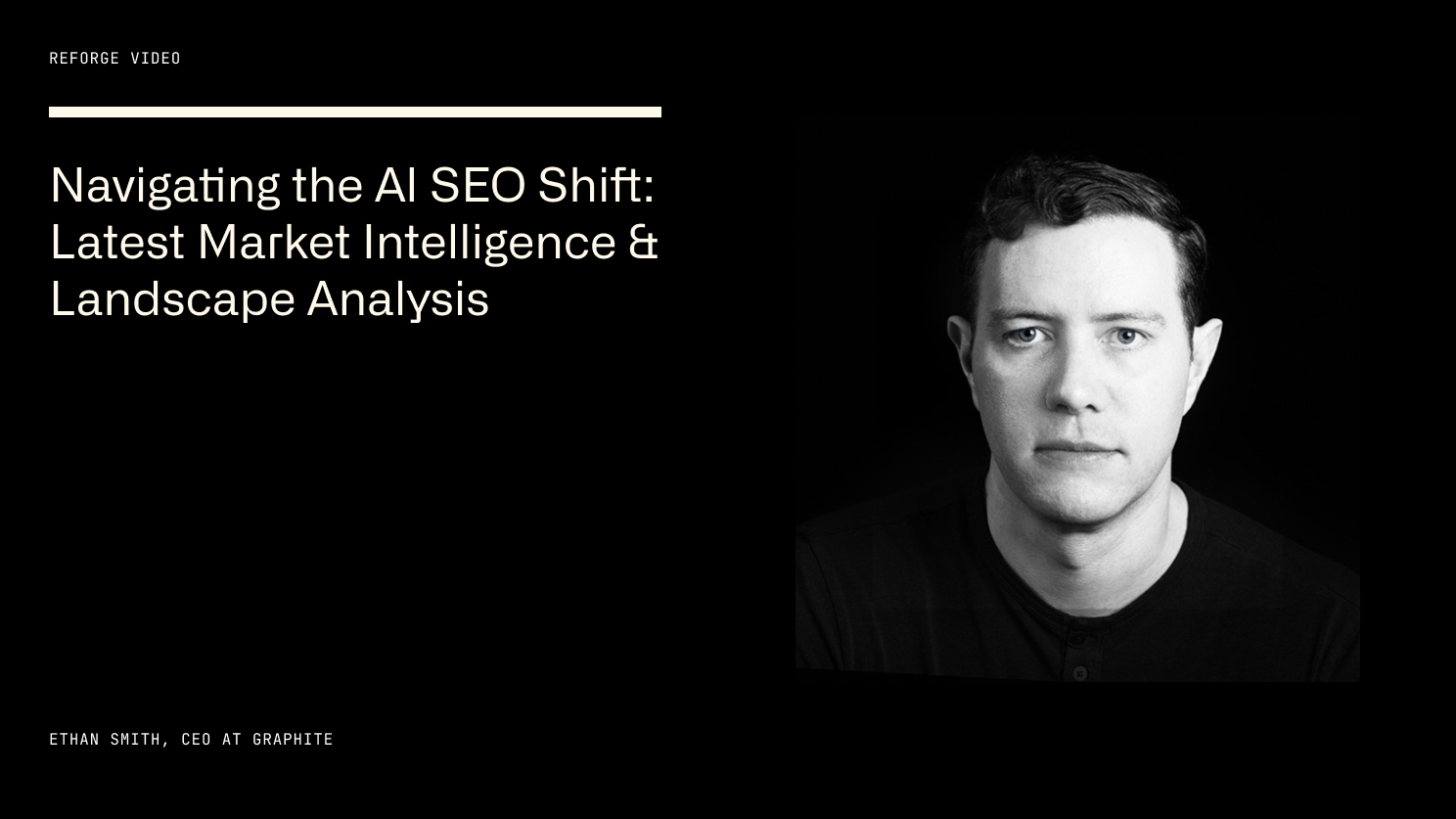Key Takeaways
- AEO Is The New SEO: ChatGPT, Perplexity, Gemini, and other chat surfaces now use search to power answers. AI chat is converging with search.
- AEO Topics: AEO topics are a cluster of *questions* that a single page targets. So, rather than targeting single questions, each landing page should target hundreds of questions with similar intent.
- Question Types: Just like in SEO, AEO has head, mid-tail, and long-tail questions. Each has different optimization strategies. Not all questions show products in the answer. Focus on Product Questions that suggest products in the answer.
- The 5% of AEO: Most work in SEO and AEO is wasted and drives no impact. But a small number of strategies can drive outsized impact. Focus on The 5% of AEO.
- Evaluate & Reproduce Results: Beware of fake case studies and blog posts. Test and validate strategies to verify that they do indeed drive impact.
How LLMs Work
LLMs & Next-Word Prediction
- ChatGPT launched in November of 2022.
- LLMs gained significant attention, but it took 1–2 years for people to widely adopt the technology.
- Early on, there was little attention or interest in how to influence or market products within AI chat.
- This was in part because LLMs were originally based on next-word prediction that trained models based on static snapshots of billions of web pages from Common Crawl and other data sets. These data sets were 1+ years old.
- Optimization for a technology with a 1+ year feedback loop is hard, if not impossible.
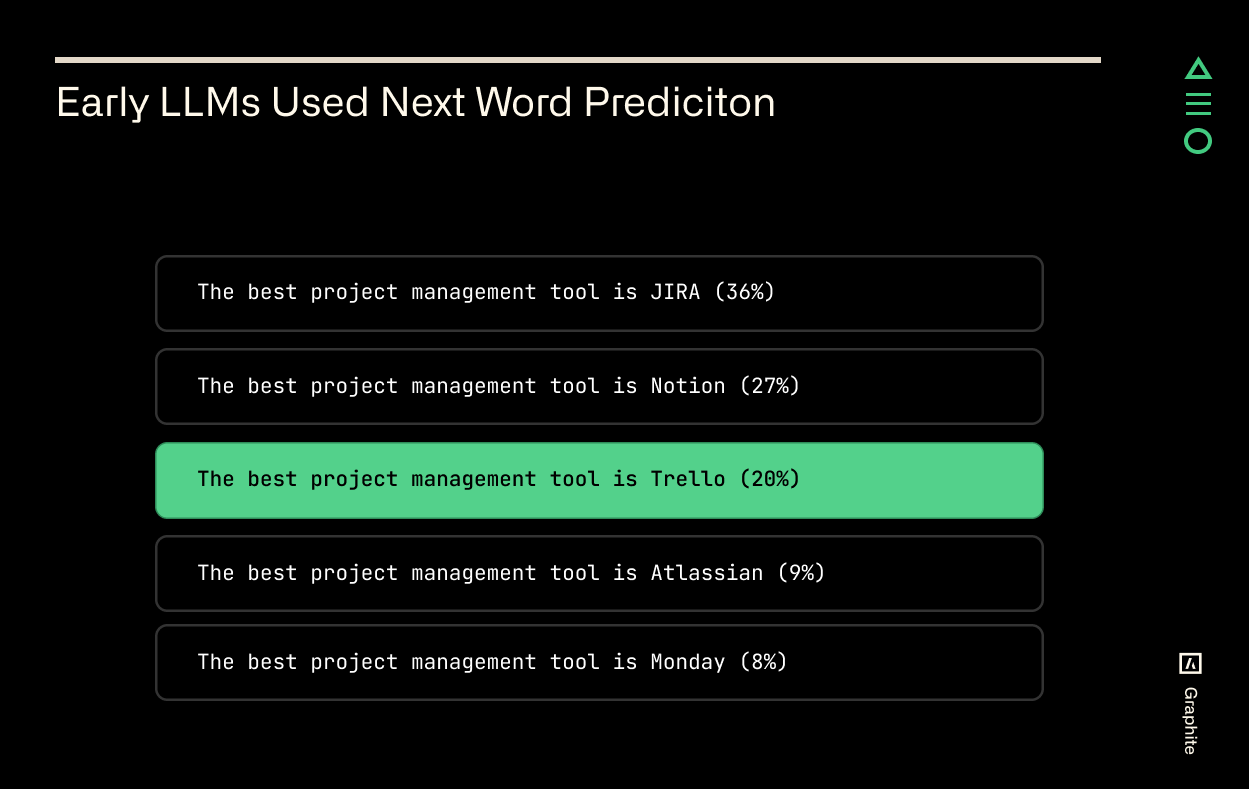
LLM + RAG
- Over the past year, LLMs have been increasingly using LLM + RAG. When you ask a question, first a search is performed, then the LLM summarizes the results.
- For example, if you search for “what’s the best project management software,” a search for “best project management software” is run, then the LLM summarizes the search results. This can use fresh data less than 1 day old versus 1+ years old.
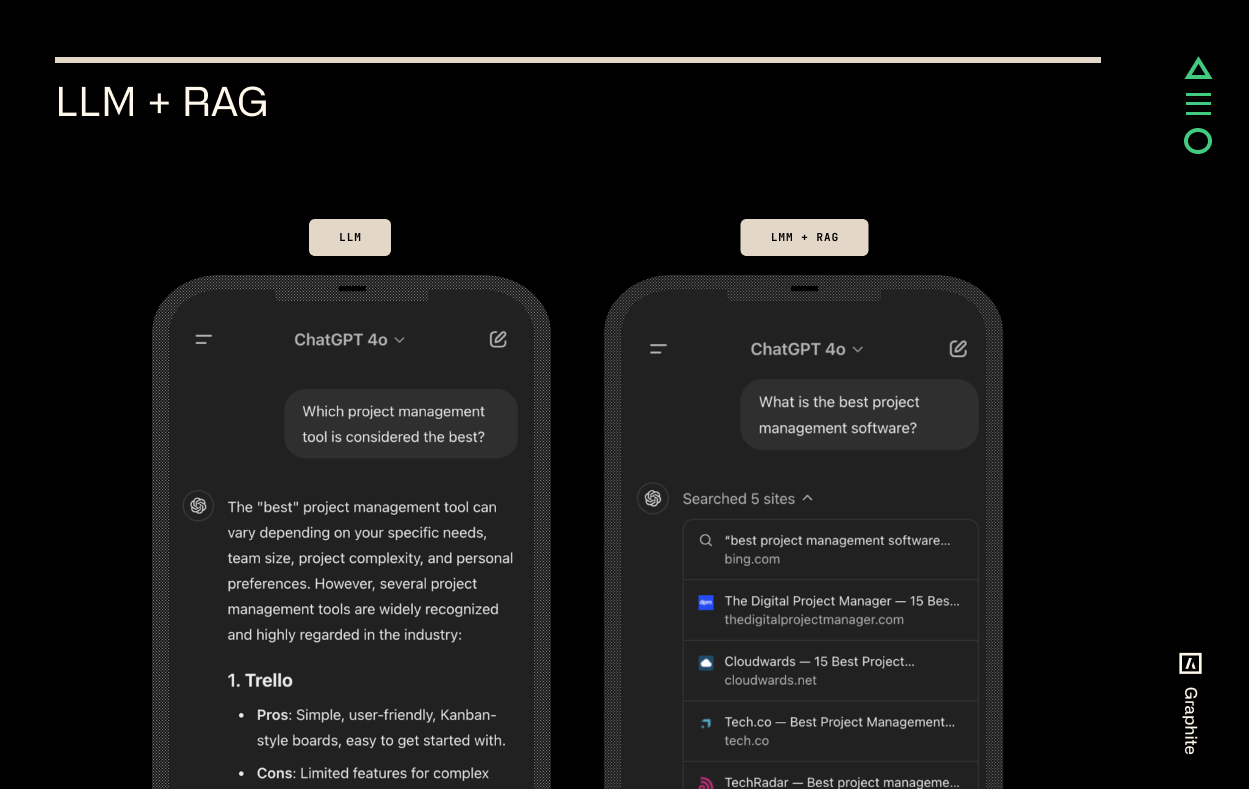
AI Chat Is Converging With Search
In many cases, people use chat to search for things:
- Perplexity.ai started from the beginning as an LLM search engine.
- ChatGPT didn’t, but over the past three months, it has also started converging with search by including clickable blue links, maps, and other traditional search elements.
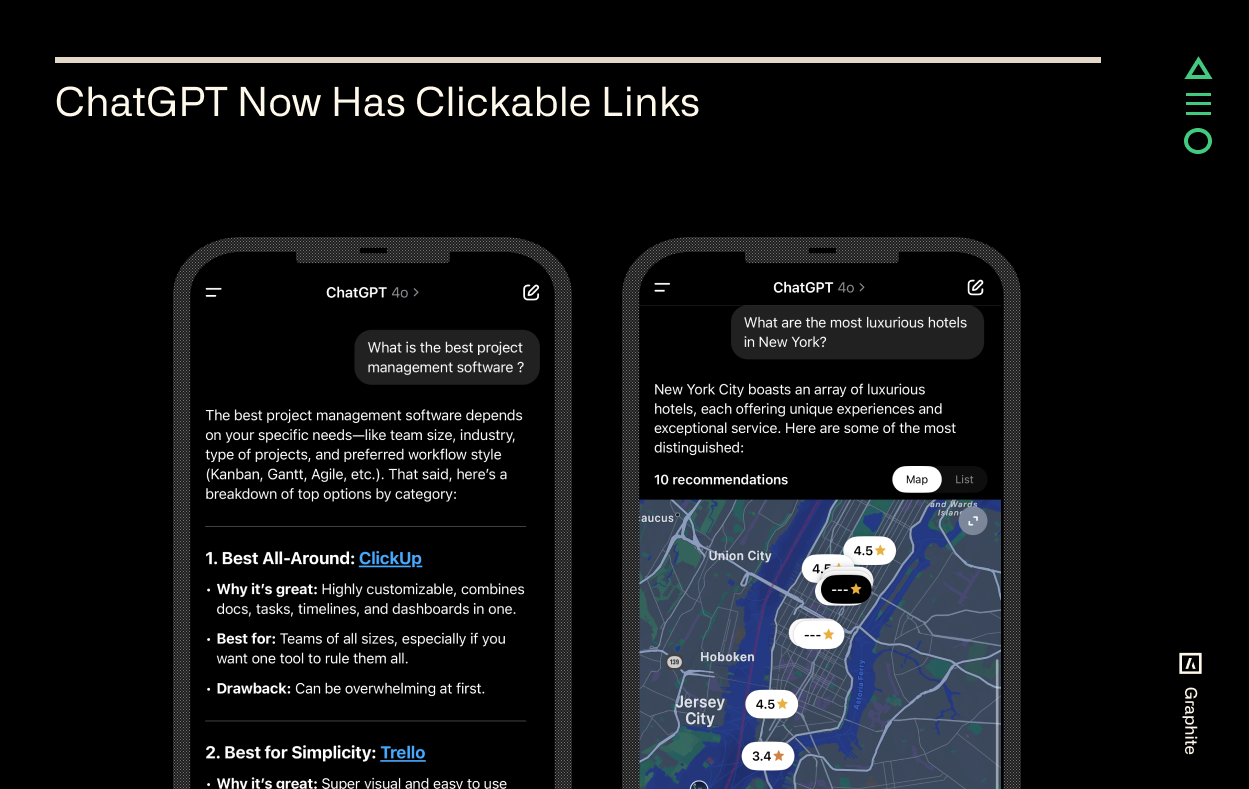
AEO Is The New SEO
- Because LLMs now use search, the experience is similar to search, and the feedback loop of changes is fast. Influencing chat experiences is now feasible.
- The core principles of search engine optimization (SEO) largely apply to answer engine optimization (AEO).
AI Is Growing, The Time Is Now
June 2024 – Temporary Burst Of Interest
In June of 2024, there was a brief buzz about optimizing for answer engines:
- At that time, we proposed an initial set of AEO strategies in a Reforge Webinar and created a Reforge SEO & AEO Course.
- However, after this initial buzz, interest waned.
January 2025 – Explosion Of Interest
Since January 2025, the interest in AEO has exploded. There has been a significant increase in LLM use.
- Many AEO platforms are raising money with venture capital, which has fueled interest.
- ChatGPT answers didn’t typically have clickable links, and when they did, they were subtle. Now, ChatGPT has prominently displayed clickable links, maps, and other traditional search elements. This has caused referral traffic from ChatGPT to dramatically increase over the past three months.
- For all these reasons, interest in AEO has exploded, and we believe this will hold and dramatically increase over the next few years.
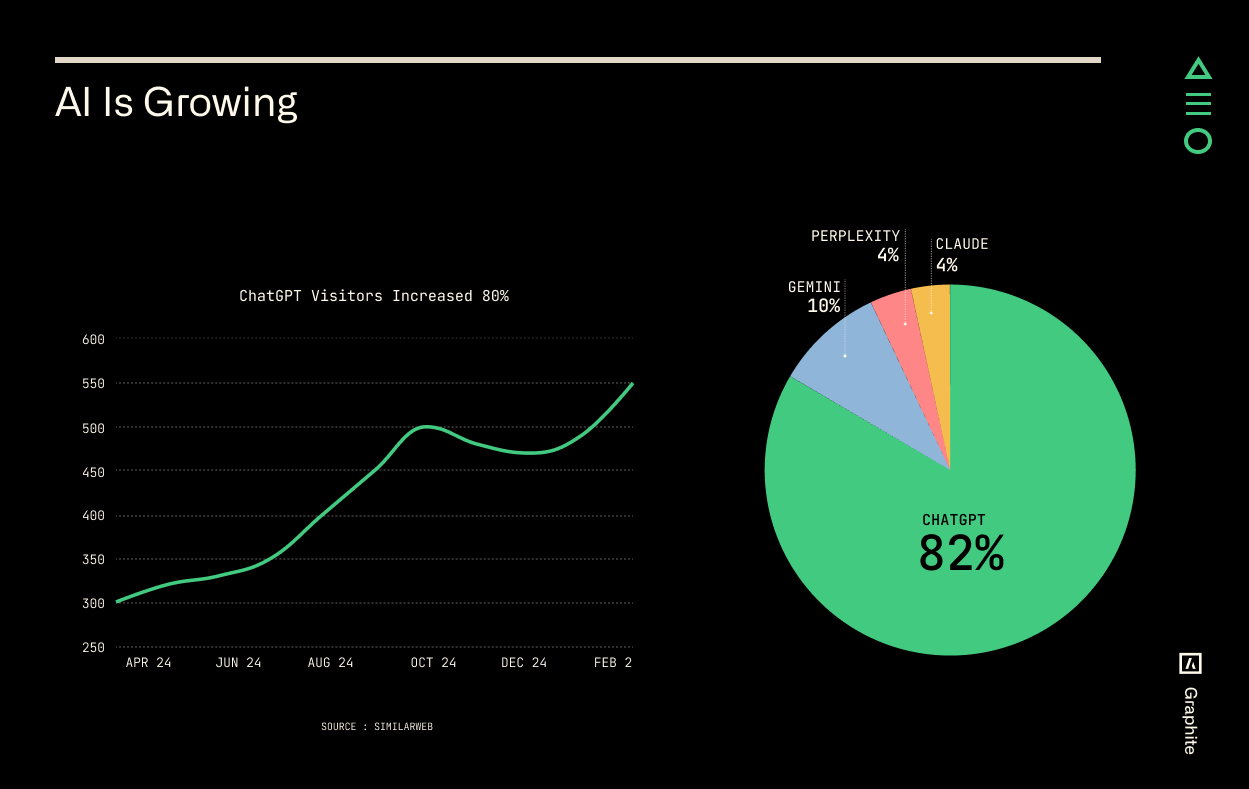
The 5%
The 5% Of SEO
- The dirty secret in SEO, is that most strategies don’t work, most landing pages drive little to no traffic, and thus, most SEO efforts are often wasted.
- How can SEO drive so much traffic if most work is wasted? A small number of strategies are highly impactful, and a small number of landing pages (typically 5% of pages) drive significant traffic. If you know the few things that work, you can drive significant impact. We call this “The 5%.”
- You can learn more about The 5% in this Reforge Webinar.
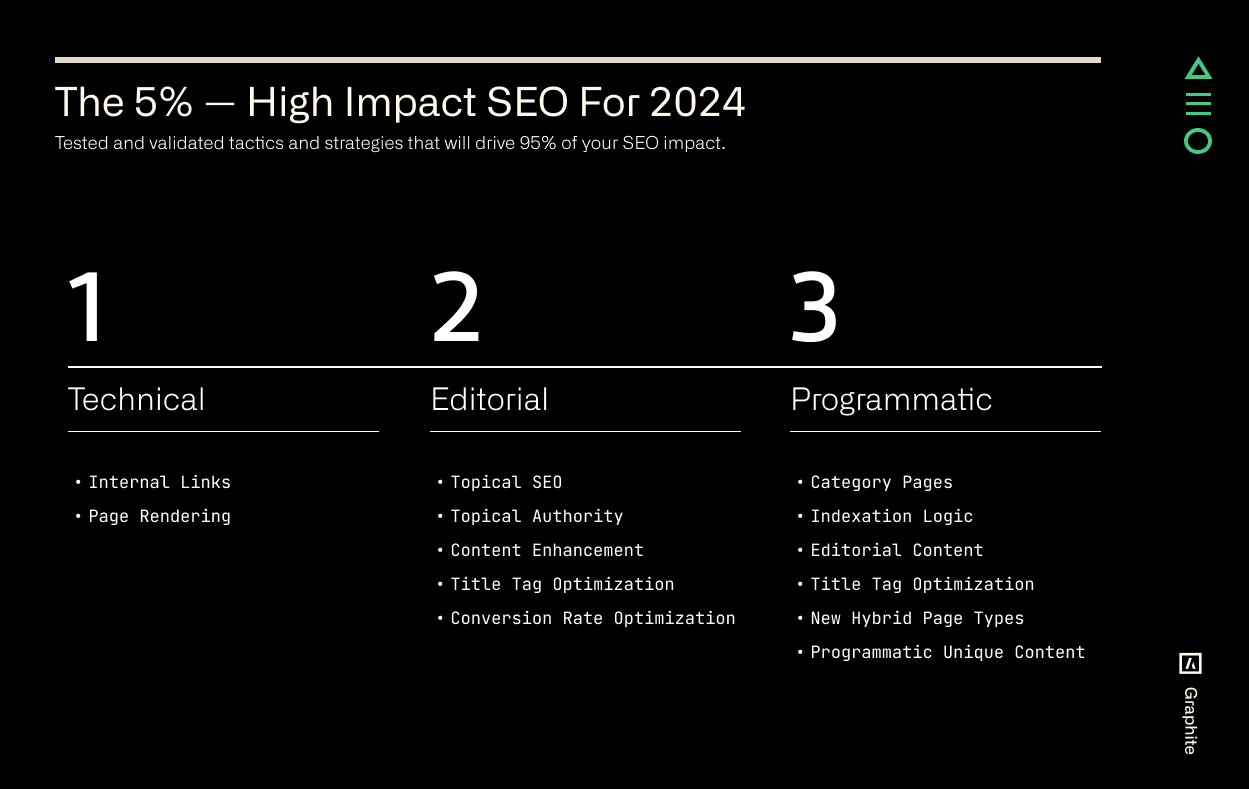
How To Find The 5%
Finding The 5% of things that drive most of the impact is simple and hard.
The 95/5 rule applies to much of growth marketing work. For most, if not all channels, most work is wasted, but a few things drive 10X impact:
- Generate Ideas — Start by generating tactic ideas that might be impactful. This can come from conducting online research, talking to industry experts, analyzing data, and brainstorming.
- Test & Evaluate — Most of these ideas will fail and drive no impact. To determine whether an idea is effective, try the idea then assess whether it had an effect. You can do this with a split test (control group versus test group) or a sequential test (compare before and after for the same group). Then, measure statistical significance between the two test groups. You can learn more about experiment design from this Pinterest Post.
- Reproduce Results — It’s common for something to work the first time but not the second time. In academic research, a result is considered accepted and valid if others can reproduce the results. For an SEO or AEO strategy to be valid, it’s important to reproduce the results multiple times before you accept it as true and impactful.
The other dirty secret in SEO is that most people don’t properly test and evaluate their ideas. People launch things and assume whether and why something worked or didn’t, never looking at what actually happened. This is why, after 20 years of SEO, people still spend most of their time on things that don’t work.
We’re about to see the same paradigm occur with AEO.
The 5% Of AEO
We’re early in AEO and in exploration mode. No one actually knows what the most impactful things are. But given our analysis and The 5% for SEO, our best guess for the most impactful things in AEO are:
- New Pages — Create landing pages for AEO topics you haven’t covered yet.
- Content Enhancement — Find AEO topics where you do have existing pages, assess whether these pages have content gaps or important questions you could answer better, then add content that fills these gaps.
- Citation Optimization — Identify the most cited URLs for AEO topics you care about, then find a way to have those citations promote your product or brand.
Technical SEO
The biggest waste of time in SEO is Technical SEO:
- In the early days of SEO, technical audits rose to prominence because technical hacks like keyword stuffing actually worked.
- Technical audits are also easy to do quickly, mostly done with automation, but the output of the audit appears to be important and substantial with lots of charts, numbers, and tasks to complete.
- The exceptions are internal links and page rendering, both of which are impactful technical SEO initiatives.
- However, in most cases, Technical SEO does not drive significant impact.
Technical AEO
We anticipate that the biggest waste of time in AEO will be Technical AEO:
- We’re already starting to see people focus on things like page speed, crawl analysis, indexation measurement, and miscellaneous “technical errors.”
- We haven’t yet tested and evaluated the impact of Technical AEO, and in some cases it may prove impactful, but we remain skeptical.
- Our recommendation is to be aware that Technical AEO will likely create significant work with little to no impact.
Beware Of Fake AEO Case Studies
Another reason people continue to do zero-impact work in SEO is fake case studies — we’ll see the same thing in AEO. This is especially true now because we’re in early exploration mode and haven’t had much time to test and evaluate what works and what doesn’t.
These are things to look out for:
- Misattribution — Usage of LLMs is growing rapidly. If traffic from ChatGPT goes up 50% due entirely to increased usage, which it will, and not due to optimizations, you can easily credit AEO work as the cause of the increase.
- Solution — To address this, isolate changes you make to a test group, then compare to a control group with no changes, and watch for statistically significant improvements in the test group over the control group.
- Relative Versus Absolute — A common strategy in SEO is to cite relative increases without context. If traffic goes from one visit per day to 10 visits per day, this is a 900% increase. However, 10 visits per day isn’t meaningful.
- Solution — Focus on the total traffic from the channel and how that compares to your business overall. Ideally, LLMs will drive at least 5% of total traffic to your site or at least be on a path where 5%+ traffic will happen in a reasonable time period. If traffic never gets to more than a few %, it’s probably not meaningful to your business.
- Vanity Metrics — A common strategy in SEO is to focus on things like # of keywords you rank for or # of impressions. This can perhaps be interesting as leading indicators early on, but ultimately, it only matters if they drive visits and conversions.
- Solution — Focus on visits and conversions as your primary KPIs. Secondary metrics like # of page and question impressions are useful leading indicators that traffic may eventually come, but on their own, they aren’t meaningful.
- Fancy Brands Without Impact — Say you do AEO for [Fancy Brand]. The assumption is that if you worked with a fancy brand, then you must have created significant impact. This isn’t always true.
- Solution — Try to assess whether there was a meaningful impact for a company. It’s perhaps even more meaningful if you drove significant impact with a lesser-known brand because this is often harder to do. Focus on whether there was impact, not just the reputation of the brand.
AEO Topics
Targeting By Keyword
SEO managers created individual pages for each keyword in order to have an exact match with the keyword. This resulted in sites having millions of programmatically generated pages to target the millions of search queries for their category. This is how Programmatic SEO rose to prominence.
When SEO started, the focus was on keyword research. Early search technology was simplistic and didn’t have a semantic understanding of the search. Because of this, ranking for a search query meant targeting a single keyword.
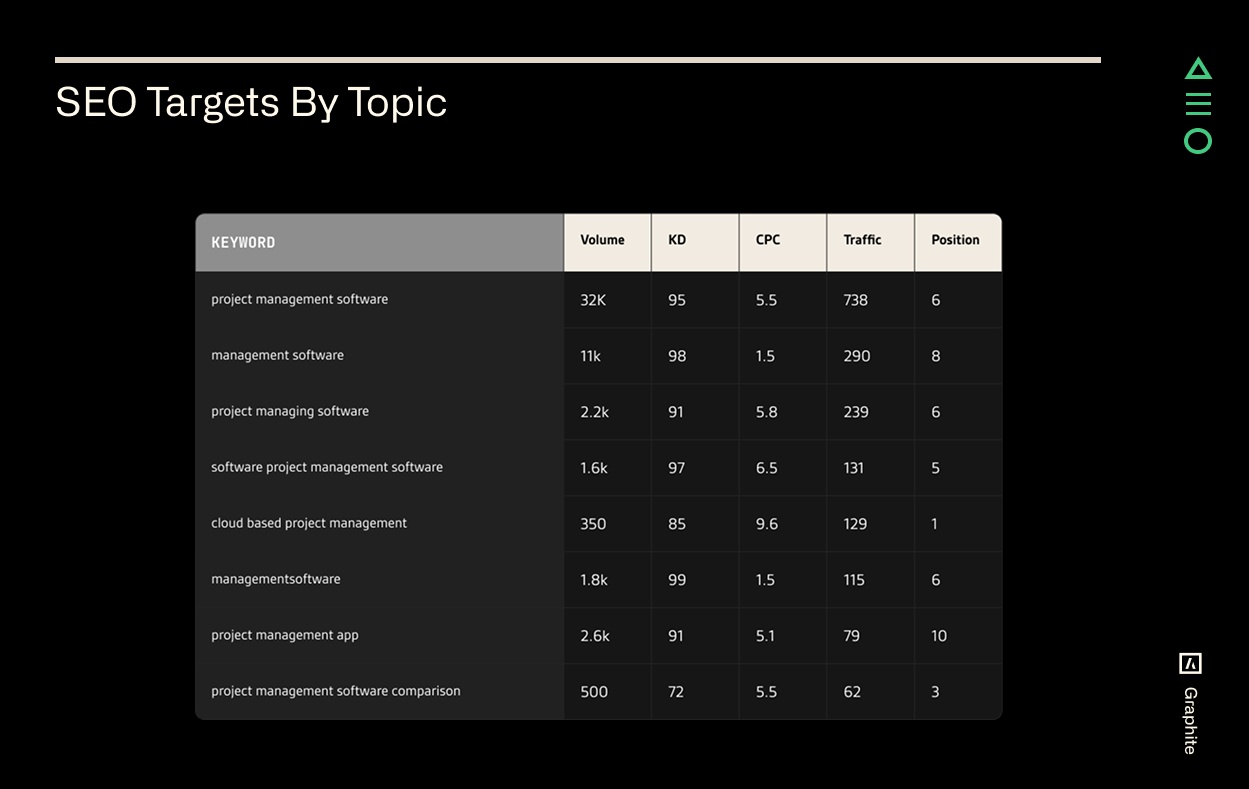
SEO Topics & Topic Research
A Topic is a cluster of many keywords that all share a similar search intent. There are many ways to group keywords into topics.
- This Reforge Artifact can help you group keywords into topics and perform topic research in SEO.
- You can learn more about topical SEO in the Reforge SEO & AEO Course.
Question Research
The same principles of grouping keywords into topics in SEO apply to AEO.
AEO Topics & Question Research
A topic in AEO is a cluster of many questions with a similar search intent. To target questions in AEO, you can create single pages that fulfill the intent of many similar questions.
Search Volume Of Questions
- Keyword search volume data in SEO originates from Google ad products. Google provides search volume data to help advertisers effectively build advertising strategies.
- This data is then used by organic search engine marketers to build SEO strategies.
- However, there are no ad products yet for AI products, and there are no truth sets for question behavior.
- OpenAI, Perplexity, and others will most certainly introduce ads into their products, after which, we’ll likely have true data sources that indicate the popularity of different questions. Until then, we have to guess which questions are asked the most.
The Long Tail of SEO Keywords
In search, a common target is the long tail of search keywords:
- Head terms — high search volume, often with high difficulty (“project management software”).
- Mid tail terms — medium search volume, often with moderate difficulty (“project management software for small businesses”).
- Long tail terms — low search volume queries, often with low competition (“project management software for construction management small business”).
SEO Topic Landscape
As discussed above, Google search now groups keywords:
- A single topic can often target head, mid, and tail keywords with a single page versus three pages.
- So, rather than focusing on individual keywords in a long tail, there’s a distribution of more or less popular topics.
The Long Tail of AEO Questions
In AI chat, the same paradigm applies:
- Head questions — high search volume, often with high difficulty (“project management software”).
- Mid tail questions — medium search volume, often with moderate difficulty (“project management software for small businesses”).
- Long tail questions — low search volume queries, often with low competition (“project management software for construction management small business”).
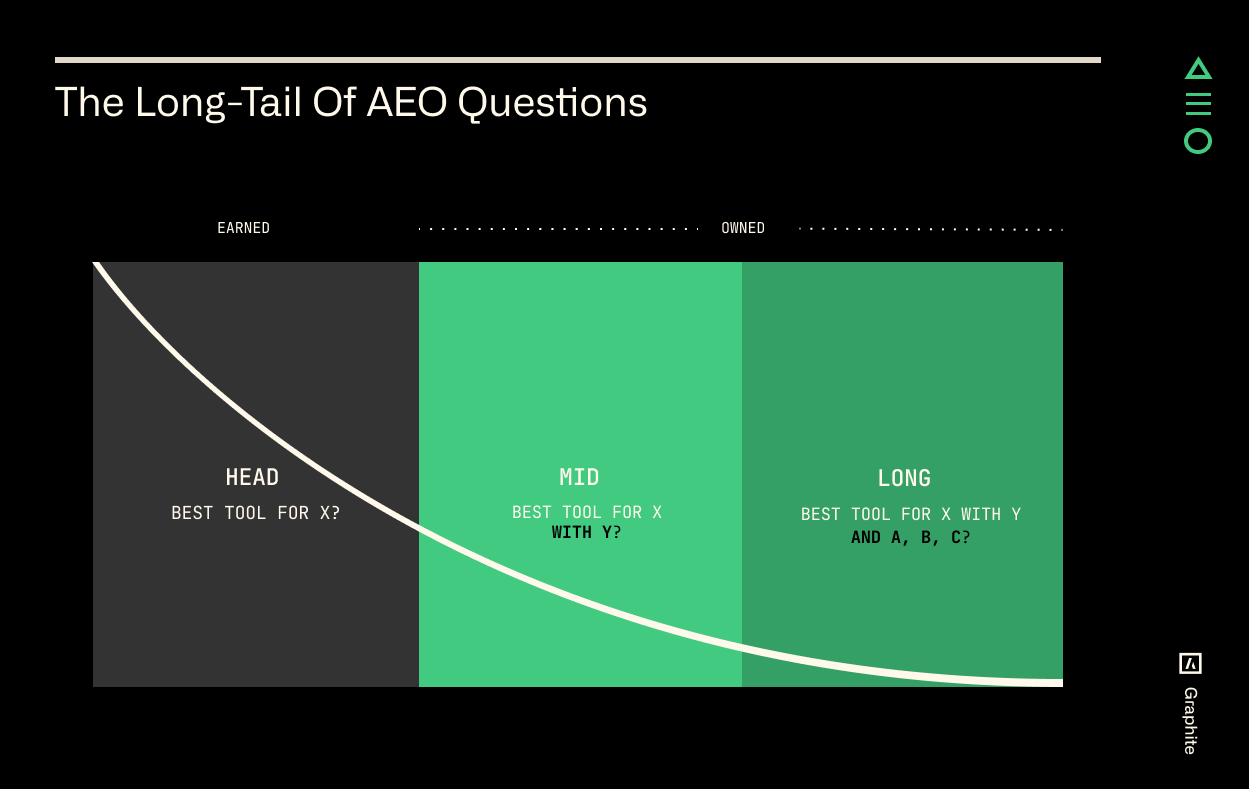
Search Vs. Conversation
- In search, users often search once, see results, and refine their search with something more specific.
- But search doesn’t save state. If you search for “project management software” then refine your search to “project management software for small businesses,” that search doesn’t consider your previous search behavior — your state and prior context isn’t saved, and each search is independent
- AI is built to facilitate conversations where a user starts with a question like “what’s the best project management software” then asks follow-up questions like “which of these has an API?” or “which are available in Spanish?” In other words, your state is saved.
- This facilitates long conversations with many follow up questions.
- Because of this, the landscape of questions differs from search in that you need to help answer the many follow-up questions from the original question, not just the original question.
Owned Vs. Earned
- In search, most of the impact comes from your site ranking for terms (owned).
- However, in AI, LLMs summarize many search results into a single answer.
- Let’s say you want to rank for “what’s the best credit card?” At best, you can rank a single time for the search output for this question. But, there are many other results included as citations, and to fully optimize, you need to be mentioned by the other citations (earned).
- Further, the most popular questions typically show publisher sites in their search (e.g., Forbes, NerdWallet, People Magazine) and not product companies like Ramp.
- However, the more specific your question, the more often product companies like Ramp appear in search, and the less publisher sites do.
- So, the more specific the question, the more an owned strategy works, and the more general a question, the more an earned strategy works.
Product Questions
- In search, a company can rank any keyword, and some keywords are more valuable than others.
- High intent searches like “project management software” are very valuable to win. Low intent informational queries like “definition of project management” have relatively low value. But, all searches can drive some business value to companies.
- In chat, this isn’t the case. Many questions show no products and likely never will.
- If you ask “how can I fix pain in my shoulder?” you’ll see helpful information but no products are mentioned. Ranking for this question in the LLM’s search has no value and likely never will.
- If instead you ask “what are the best virtual physical therapy solutions for pain in my shoulder?” Hinge Health and other products are suggested solutions. This question does have business value. We call these Product Questions. So, some questions show products, and some don’t.
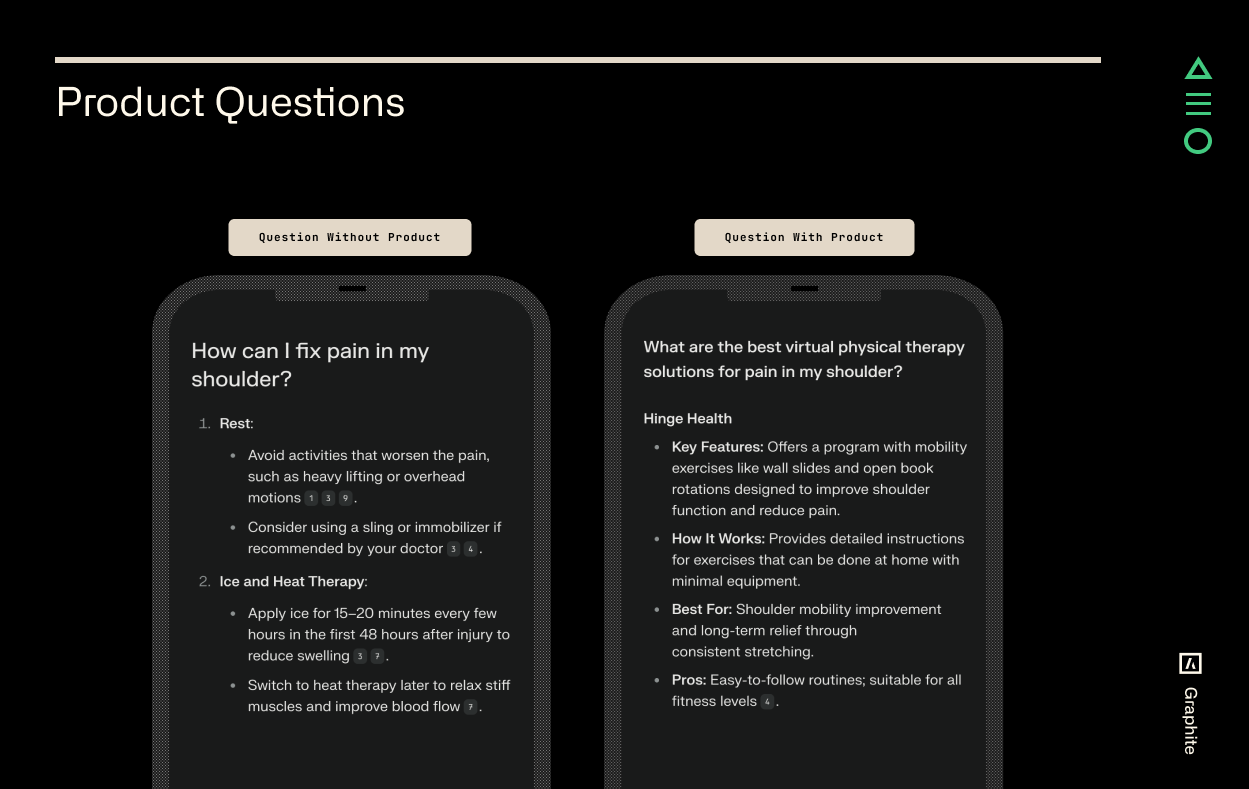
Based on our research, most questions do have products.
- Travel, commerce, local, tech, and crypto questions show products the most often.
- Food and news show products less than half the time.
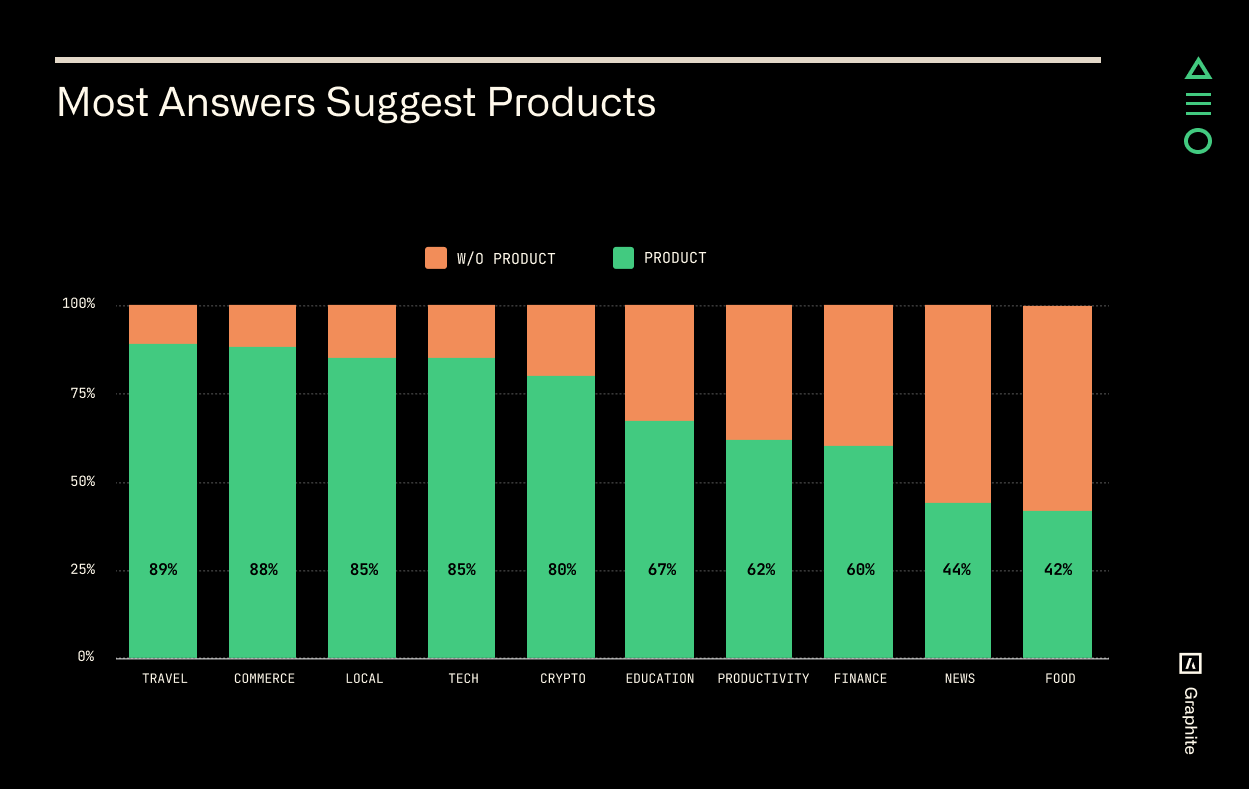
Question Research Tools
- There are currently no tools to help with Question Research, however we expect such tools to come soon.
- Graphite has built its own question research tool, which takes keyword search data and transforms these into questions. This assumes that the questions asked in AI are similar to the keywords searched for in search.
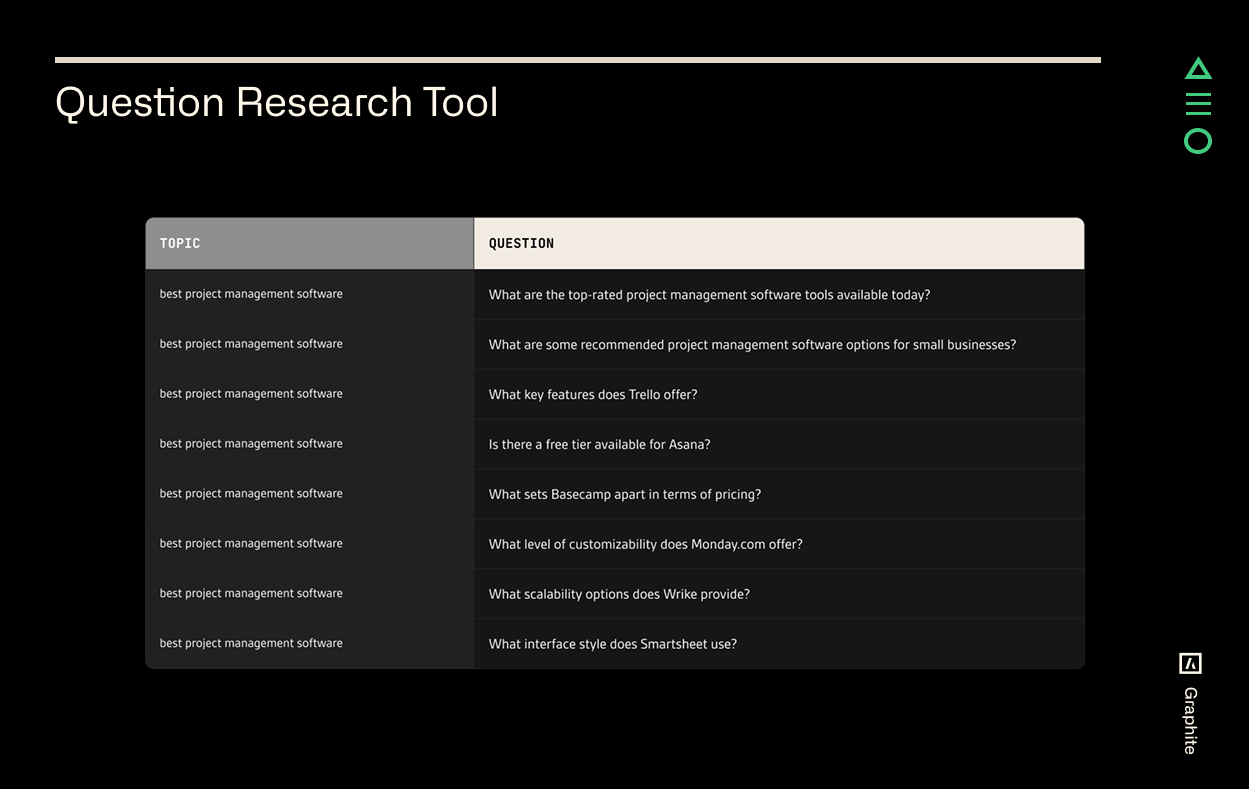
Measurement
SERP Tracking
In SEO, people track search engine rank position (SERP). Each URL has a single position for a given keyword. Google has over 90% market share, so few measure other search engines.
Tracking Share Of Answers
In AI, it’s more complicated.
- Share Of Answers: We can combine the data for tracking by surface, question variant, and run to show a distribution of how often your product appears. Similar to “Share Of Voice” in marketing, we call this “Share Of Answers,” which is a distribution or frequency of appearance.
- Track By Surface: There are multiple popular surfaces in AI. The most popular are ChatGPT, Perplexity, Gemini, and Claude. You need to track performance across all popular chat surfaces rather than a single surface.
- Track By Question Variations: Above, we discussed that an AEO topic is a cluster of hundreds or thousands of questions that all share a similar intent. Tracking a single question only tells you your performance for that one question. To get a full understanding of performance, you need to track multiple questions within a single AEO topic.
- Track By Run: In Google, if you search the same keyword multiple times, the search results will have little to no difference. In AI, the same question can yield different answers each time. You need to check the same question multiple times in order to see how often your product appears.
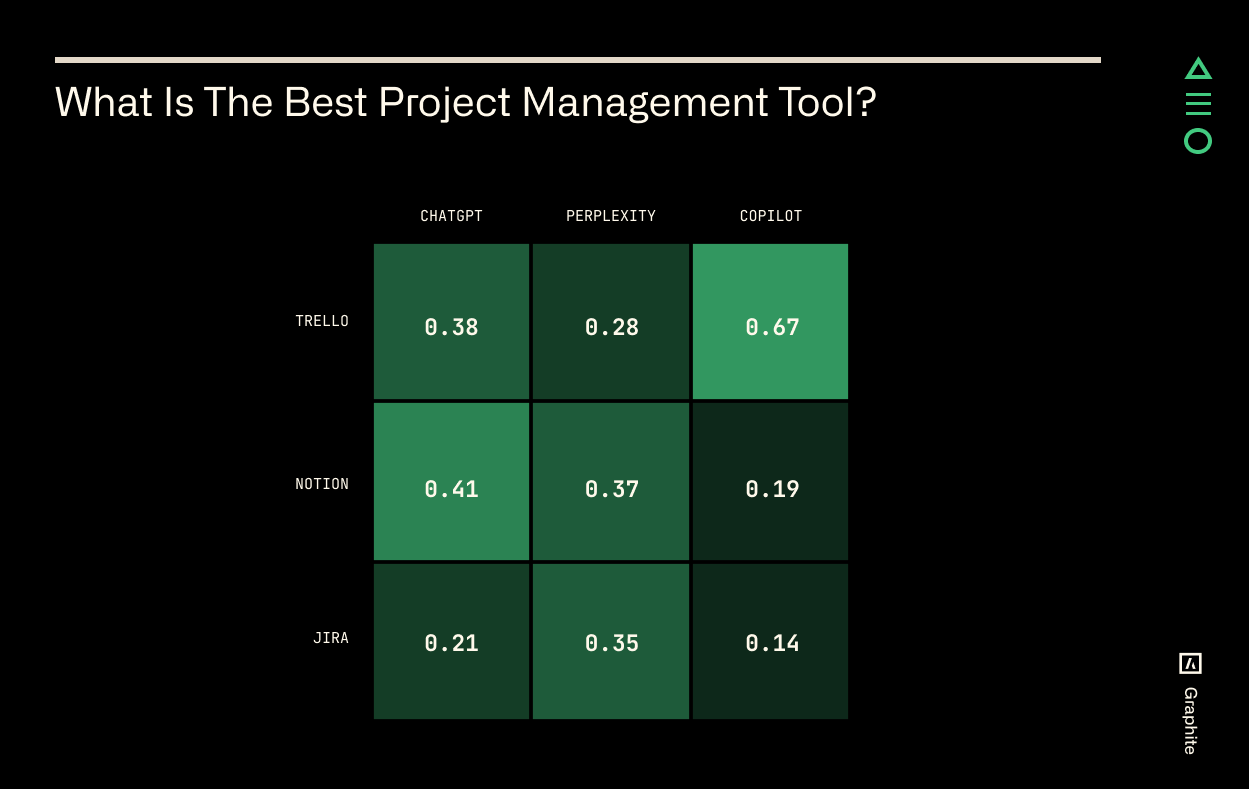
Tracking Citations
- In Google, backlinks build your pagerank and affect your overall authority and ability to rank for competitive terms. In AEO, citations serve a similar purpose, but with different dynamics.
- In LLM + RAG, RAG returns a set of search results, then the LLM summarizes those results. The more times your product is mentioned the citations, the more likely it is that the LLM will suggest your product.
- In SEO, a link from the homepage of the New York Times is a big win. In AEO what matters are the specific URLs that are part of the search result set. In order to appear in an answer, you need to be mentioned by as many of the specific URLs included in the citation set as possible.
- You can track whether you are mentioned by the relevant citations to assess performance and opportunities to optimize.
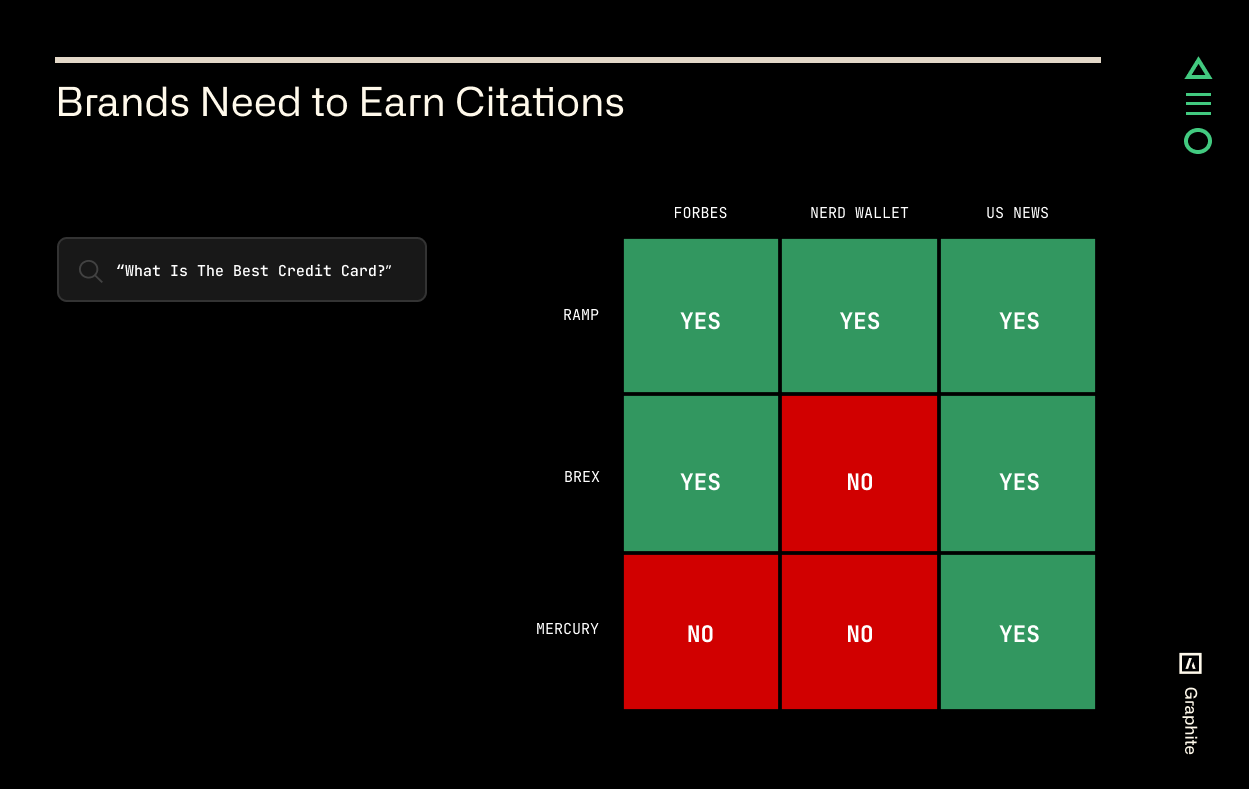
AEO Tools
We are now asked multiple times a day about which AEO tools are best.
- The main useful feature shared among all tools is AI tracking. While everyone is building optimization tools and other features, this has not been figured out yet.
- For more information on AEO, you can reference our AEO tools list.
- Focus primarily on AI tracking and use the least expensive tool that completes the job you need. As these tools evolve, watch which do more than tracking and consider whether the functionality is useful enough to switch and pay extra.
Recommendations
If you're exploring AEO now, these are our recommendations.
- Invest Now In AEO: We believe now is the time to invest in AEO because the channel is growing rapidly, there is a large increase in referral traffic from AI, and the strategies to optimize in AEO are now more clear.
- AEO Topics: Identify the most important AEO topics and start tracking them.
- New Pages: Create landing pages for AEO topics you haven’t covered yet.
- Content Enhancement: Find AEO topics where you do have existing pages, assess whether these pages have content gaps or important questions you could answer better, then add content that fills these gaps.
- Citation Optimization: Identify the most cited URLs for AEO topics you care about, then find a way to have those citations promote your product or brand.
- Technical AEO: Be wary of technical AEO. Focus little to no time on it. As with technical SEO, it likely will drive little to no impact (in most cases.
- AEO Tools: There are dozens of AI tracking tools, and ultimately, they all perform the same task - tracking how often your product appears in answers. As such, choose the least expensive tool that does the job you need.
- Evaluate & Reproduce: Be wary of blog posts and case studies. They can often be misleading. Test and evaluate strategies yourself. Reproduce them. Then, you will be able to identify The 5% of AEO that drive outsized impact.
- Share Learnings: As you evaluate and reproduce, share what works and what doesn’t so we can all learn together. As we find what drives impact in AEO at Graphite, we will share our learnings.
